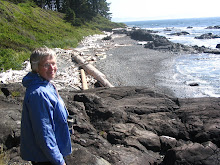
Tags or metadata become the bread crumbs to follow back to original sources of information on the internet. Rather than following a taxonomy created by others, an individual can create their own system of tags (called a folksonomy). I watched an interesting panel discussion from 2005 in which people from Delicious, Flickr, and Wikipedia (Butterfield, Shirkey, and Wales in picture) discussed their evolving use of tags and their sharing of the power with the public.

What are some of the implications for teaching and learning as we use social bookmarking sites? First of all, these sites can help teachers to better organize their favourite sites on the internet. Part of this will be learning how to create more useful tags. One of the issues there is with the use of multiple word tags which at the present time is handled is a variety of ways. For example a tag such as Saskatoon history could be typed as Saskatoonhistory, Saskatoon_history or Saskatoon-history. If there is no common way of creating this tag, people using a different typing, would not find all of the links to information.
We need to teach students to create tags and to use to tags to uncover information. Using tags for searching is better than using Google since Google returns results based on the popularity of a site not upon the reliability of information at that site.
A class account may be set up for students to save their sites along with tags so that others in the class may access those sites. For example, if a grade 5 class at Caroline Robins School was tagging and saving sites about the ocean, they could include CaroRob5 in each tag. Then everyone in the class could find all of the sites tagged in this manner.
Students will need to be able to skim and scan information on websites to find good sites. This will be a reading skill that will need to be modelled and taught explicitly. As well, students will need to learn to develop good tags or metadata for information. I believe that using concept maps will help in this learning. (Concept map templates) One author (DesRoches, 2007) suggested that developing the skill of social bookmarking should be part of the technology skills continuum which should be taught in grade 9.
One last way in which social bookmarking could benefit teacher-librarians is in their collaborative work with classroom teachers. As teacher and teach-librarian sit down to plan units and uncover resources, they could decide on common tags for information. Then they could save resources in Delicious or some other social bookmarking site. This would make sharing of those resources and return to those sources much easier.
I have learned a lot about social bookmarking over the past few days. Now I just have to figure out how to retroactively tag the sites which I moved over from Favourites into Delicious. Then I will really be able to make this aspect of technology work for me.
References:
Schachter, J., Butterfield, S., Wales, J., & Shirky, C. (2005) Folksonomy: How I learned to stop worrying and love the mess. Panel discussion recorded at the O'Reilly Media Emerging Technology Conference. http://itc.conversationsnetwork.org/shows/detail464.html
DesRoches, D. (2007). All together now: Social bookmarking offers a new way to store and share web sites. Online in School Library Journal.
http://www.schoollibraryjournal.com/article/CA6403269.html
![Reblog this post [with Zemanta]](http://img.zemanta.com/reblog_e.png?x-id=44969a6d-3de8-43a6-b1f4-4b6618cb8487)





Ruth, I very much enjoy reading your blogs; you provide so much interesting information linked to supporting resources. I like your link to concept maps. Have you ever tried the bubbl.us application. It is a type of e-mindmapping program akin to the concept map. One of my other profs showed it to us.
ReplyDeleteLori
I think there is a lot to be said for teaching kids to tag (using both controlled vocabulary that the TL could add) and their own folksonomies. I think tagging is here to stay so students might as well learn to do it well now.
ReplyDelete